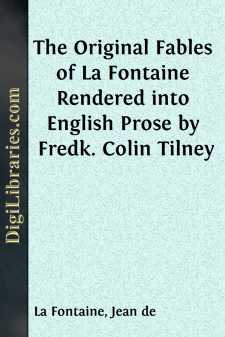Categories
- Antiques & Collectibles 13
- Architecture 36
- Art 48
- Bibles 22
- Biography & Autobiography 813
- Body, Mind & Spirit 142
- Business & Economics 28
- Children's Books 17
- Children's Fiction 14
- Computers 4
- Cooking 94
- Crafts & Hobbies 4
- Drama 346
- Education 46
- Family & Relationships 57
- Fiction 11829
- Games 19
- Gardening 17
- Health & Fitness 34
- History 1377
- House & Home 1
- Humor 147
- Juvenile Fiction 1873
- Juvenile Nonfiction 202
- Language Arts & Disciplines 88
- Law 16
- Literary Collections 686
- Literary Criticism 179
- Mathematics 13
- Medical 41
- Music 40
- Nature 179
- Non-Classifiable 1768
- Performing Arts 7
- Periodicals 1453
- Philosophy 64
- Photography 2
- Poetry 896
- Political Science 203
- Psychology 42
- Reference 154
- Religion 513
- Science 126
- Self-Help 84
- Social Science 81
- Sports & Recreation 34
- Study Aids 3
- Technology & Engineering 59
- Transportation 23
- Travel 463
- True Crime 29
Jean de La Fontaine
Jean de La Fontaine (1621-1695) was a French poet and fabulist best known for his collection of fables, "Fables de La Fontaine," published in several volumes from 1668 to 1694. His work was inspired by classical sources like Aesop and Phaedrus, and his fables often conveyed moral lessons through vivid animal characters. La Fontaine was also a member of the French Academy and admired for his wit and elegant use of language. Besides fables, he wrote poetry, plays, and stories, but his fables remain his most celebrated legacy.
Author's Books:
Sort by:
INTRODUCTION Bernard Mandeville's first extant book in English, Some Fables after the Easie and Familiar Method of Monsieur de la Fontaine, was published in 1703; it reappeared with additional fables in 1704 as Aesop Dress'd. Neither title reveals that, except for two original fables by Mandeville, the book consists entirely of verse translations from the twelve books of La Fontaine's...
more...
Jean de La Fontaine was born on the 8th of July, 1621, at Chateau-Thierry, and his family held a respectable position there. His education was neglected, but he had received that genius which makes amends for all. While still young the tedium of society led him into retirement, from which a taste for independence afterwards withdrew him. He had reached the age of twenty-two, when a few sounds from the...
more...
The Two Mules (Book I.—No. 4) There were two heavily-laden mules making a journey together. One was carrying oats and the other bore a parcel of silver money collected from the people as a tax upon salt. This, we learn, was a tax which produced much money for the government, but it bore very hard upon the people, who revolted many times against it. The mule that carried the silver was very proud of...
more...




